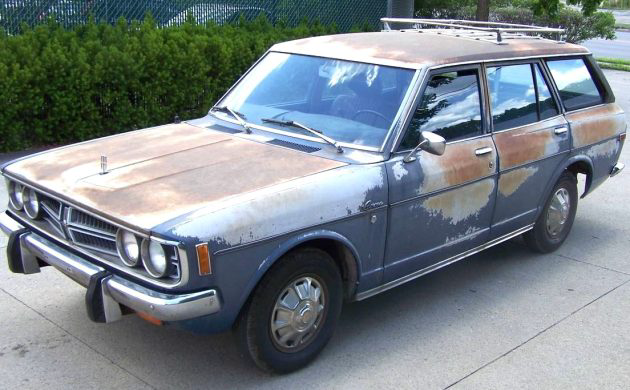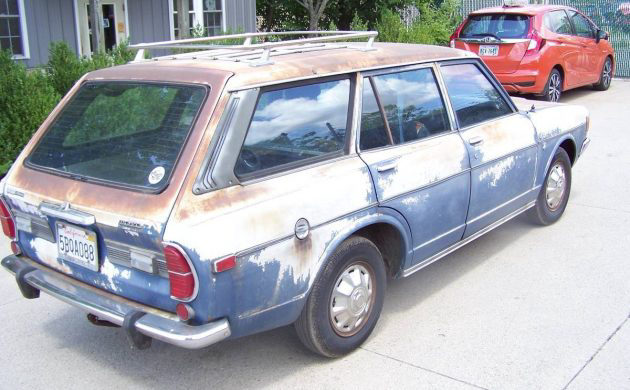The Toyota Corona was in production in Japan from 1957 to 2001. During the 1970s, it was the middle entry in the U.S. between the Corolla and Crown models (the Camry hadn’t yet arrived). Toyota’s reputation for quality was just starting to develop and it would eventually drive loads of sales with American buyers. This 1973 Corona wagon is the epitome of the definition of patina when it pertains to automobiles. Its blue paint is barely recognizable from baking in the California Sun over the years.
We don’t know the car’s ownership history other than the seller has owned it for two years. He/she bought it in California in 2022 (it still wears those license plates) and brought it to Ohio. It’s a running and driving wagon having been treated to some new suspension pieces and tires. It looks well used and you could decide to opt for a full restoration. Or you could just opt to say, “What the heck” and use it as-is even though it looks rougher than it performs.
There is no indication of rust on this Toyota and the interior is well-used. You could clean up the back seat and install new front upholstery and carpeting. The seller provides ample photos, so there should be no surprises other than there are no photos of the engine compartment. A 4-banger should reside there, paired with a Toyota automatic transmission.
The odometer read just 44,000 miles and that could be legit as the transport may have simply spent most of its time in the pizza oven. One photo shows air conditioning vents under the dash, but the seller doesn’t elaborate if it works. Located in Lorain, Ohio, and available here on craigslist, the Japanese wagon could fall into the cheap wheels category at $4,900 – assuming you decide not to restore it.






Weeeeeelll( sound of screeching tires), how can I possibly add anything constructive RIGHT AFTER THE AMC POST? ( gathering composure), It’s okay, and Russ knows it. It’s the variety of the site, not what some hothead from Beer City thinks. For the record, this was the ultimate game changer. Oh, we chuckled, it will never replace our SSTs, LTDs or Impalas or so we thought. Here’s where the screeching tires comes into play. My opinions may be biased, but this car was a mere SHRED of what we, as Americans were used to in cars. The Japanese? Those sandal wearing goldfish tenders? Bosh, flimshaw,,,but truth was, they had the vision, and had us by the “gas hose”. People, possibly in a panic mode, lined up for blocks for these. Well, not really, but every person in middle class America knew someone that left the USA brands for this. It’s unfair to continually list these cars shortcomings, they had a duty, and filled it well, While I read only about 20,000 Coronas were sold in ’73, it opened up the floodgates for foreign cars, and word got out, cars like this, probably has Lord knows, hundreds of thousands of miles. It’s unusual to see one at all.
It didn’t hurt Toyota that Americans were driving thousands of Vegas and Pintos at the time and were realizing that “these cars are crap, let’s buy imported”.
I agree. My uncle, who was a contractor and always drove Ford trucks (mostly F100’s early on) but decided to buy a 1969 Datsun 520 (I think). One of his hired hands had an older model Datsun truck which he raved about. My uncle kept the Ford but wanted to see if the tiny Datsun would handle his workloads. He told me he was definitely surprised at how much weight it could carry but it scared the crap out of him when trying to stop with a full and heavy bed. He loved that truck and, except for a couple of recurring electrical problems (starter and solenoid) he had no complaints.
I believe the imports were already making a foothold in American drivers before Vegas and Pintos. The GM and Ford competition at that time just solidified the move to Japanese cars and trucks.
It also didn’t hurt that Toyota paid close attention not only to what America was manufacturing, but also how Americans responded to their original offerings. That’s why most of the early Japanese vehicles imported went from being perceived as tinny wanna bes to what they quicky became in the 80s. And the American auto industry sat back and watched. Or didn’t.
I tried to buy a new 1983 Honda Civic wagon for cash at my local dealer, but another buyer signed purchase paperwork while I was unsuccessfully trying to get a better deal. Fortunately, the buyer’s financing fell through and I was “allowed” to purchase it for full price. Hondas were on “allocation” in those days due their popularity. If I had missed that wagon, it would be several months until another one showed up, according to the dealer. I was already sold on imported cars, and except for Dodge trucks and a 1960 Falcon wagon, I haven’t owned an American car (until recently) since 1978.
Lovely looking car. Assuming the patina is on the surface and there’s no rust holes to see, that the car can still be driven under its own power, I’d be willing to pay the asking price.
It runs and drives well, read the Craigslist ad about it! 🙂
I’m not a fan of (this) patina. And, history aside, it looks pretty functional, an appealing attribute at any time. I would take a couple of months to strip the body of all chrome, remove layers of paint and surface rust, prep, prime and paint. Re-attach chrome. Replace the carpeting, clean up the interior. This might be a good vehicle to learn seat repair. This seems like a great project to me.
Earl Shieb or Maaco it , recover the seat, make sure Air Conditioner works. Unique car that no-one else has. Weird Automatic on column, but who cares.
This particular variation was a one-year-only car, at least on the US market. Toyota hadn’t sold the Corona wagon (as opposed to the bigger Mark II and smaller Corolla wagons) in the US until ’73, and the 1974 model was fully redesigned.
I owned a 1975 Corona 2 door automatic with manual steering and power brakes. It was the slowest car that I have ever driven – zero to 60 was almost undoable unless on a downhill run. But built like a bank vault and tough as nails.